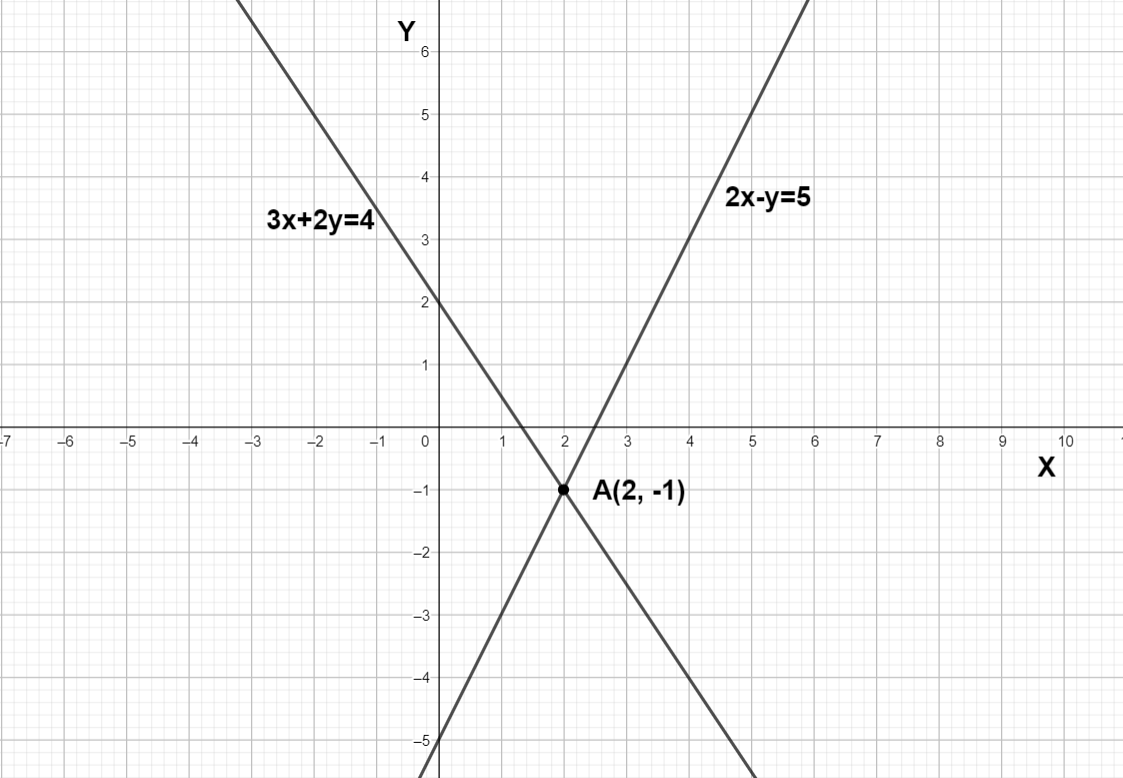
How do you solve the system by graphing the linear system $2x-y=5$ and $3x+2y=4$ ?
Answer
538.5k+ views
Hint: The above 2 equations are of straight lines. The solution to the system of equations will be the intersection between 2 lines. There will be no solution if 2 lines are parallel to each other and infinite solution if both lines are the same.
Complete step-by-step answer:
General formula for the line is $y=mx+c$
$2x-y=5$ and $3x+2y=4$ are equations of straight lines. The intersection point will be the solution of the system.
General equation for the line is $y=mx+c$ where m is the slope and c is the y intercept, we can write $2x-y=5$ as $y=2x-5$ and if we compare $y=2x-5$ with $y=mx+c$ we get the slope is 2 and y intercept is equal to – 5, in $3x+2y=4$ the slope is $-\dfrac{3}{2}$ and y intercept is equal to 2 so let’s draw the graph and find out the point of intersection.

We can see that the point of intersection is A(2 , - 1) x coordinate is the solution. So 2 is the solution.
Note: Another method is to solve by determinant method
Suppose there are 2 linear equation ${{a}_{1}}x+{{b}_{1}}y={{c}_{1}}$ and ${{a}_{2}}x+{{b}_{2}}y={{c}_{2}}$ the solution to this problem let’s take
D= $\left| \begin{matrix}
{{a}_{1}} & {{b}_{1}} \\
{{a}_{2}} & {{b}_{2}} \\
\end{matrix} \right|$
A= $\left| \begin{matrix}
{{b}_{1}} & {{c}_{1}} \\
{{b}_{2}} & {{c}_{2}} \\
\end{matrix} \right|$
B= $\left| \begin{matrix}
{{a}_{1}} & {{c}_{1}} \\
{{a}_{2}} & {{c}_{2}} \\
\end{matrix} \right|$
$x=-\dfrac{A}{D}$ and $y=\dfrac{B}{D}$ Where $D\ne 0$
If $D=0$ and any one of A and B is not equal to 0 then there will be no solution for the system of equation
If $D=A=B=0$ there will be infinitely many solutions to the system of equations.
If $D\ne 0$ there will be one solution for the system of equations.
In this case ${{a}_{1}}=2,{{b}_{1}}=-1,{{c}_{1}}=5$ and ${{a}_{2}}=3,{{b}_{2}}=2,{{c}_{2}}=4$
Solving the determinant D = 7 , A= - 14 and B = -7
So $x=-\dfrac{A}{D}$
So x = 2
And $y=\dfrac{B}{D}$= - 1
While solving the system of linear equations we can imagine the equation having 2 unknown as equations of straight in 2-D Cartesian plane so 2 equations means 2 lines will intersect at 1 point unless both lines are parallel or both lines are overlapping. Same goes with 3 unknowns: we can imagine the equations as equations of plane in 3D geometry and then solve for the unknown variables.
Complete step-by-step answer:
General formula for the line is $y=mx+c$
$2x-y=5$ and $3x+2y=4$ are equations of straight lines. The intersection point will be the solution of the system.
General equation for the line is $y=mx+c$ where m is the slope and c is the y intercept, we can write $2x-y=5$ as $y=2x-5$ and if we compare $y=2x-5$ with $y=mx+c$ we get the slope is 2 and y intercept is equal to – 5, in $3x+2y=4$ the slope is $-\dfrac{3}{2}$ and y intercept is equal to 2 so let’s draw the graph and find out the point of intersection.

We can see that the point of intersection is A(2 , - 1) x coordinate is the solution. So 2 is the solution.
Note: Another method is to solve by determinant method
Suppose there are 2 linear equation ${{a}_{1}}x+{{b}_{1}}y={{c}_{1}}$ and ${{a}_{2}}x+{{b}_{2}}y={{c}_{2}}$ the solution to this problem let’s take
D= $\left| \begin{matrix}
{{a}_{1}} & {{b}_{1}} \\
{{a}_{2}} & {{b}_{2}} \\
\end{matrix} \right|$
A= $\left| \begin{matrix}
{{b}_{1}} & {{c}_{1}} \\
{{b}_{2}} & {{c}_{2}} \\
\end{matrix} \right|$
B= $\left| \begin{matrix}
{{a}_{1}} & {{c}_{1}} \\
{{a}_{2}} & {{c}_{2}} \\
\end{matrix} \right|$
$x=-\dfrac{A}{D}$ and $y=\dfrac{B}{D}$ Where $D\ne 0$
If $D=0$ and any one of A and B is not equal to 0 then there will be no solution for the system of equation
If $D=A=B=0$ there will be infinitely many solutions to the system of equations.
If $D\ne 0$ there will be one solution for the system of equations.
In this case ${{a}_{1}}=2,{{b}_{1}}=-1,{{c}_{1}}=5$ and ${{a}_{2}}=3,{{b}_{2}}=2,{{c}_{2}}=4$
Solving the determinant D = 7 , A= - 14 and B = -7
So $x=-\dfrac{A}{D}$
So x = 2
And $y=\dfrac{B}{D}$= - 1
While solving the system of linear equations we can imagine the equation having 2 unknown as equations of straight in 2-D Cartesian plane so 2 equations means 2 lines will intersect at 1 point unless both lines are parallel or both lines are overlapping. Same goes with 3 unknowns: we can imagine the equations as equations of plane in 3D geometry and then solve for the unknown variables.
Recently Updated Pages
Master Class 12 Business Studies: Engaging Questions & Answers for Success

Master Class 12 Economics: Engaging Questions & Answers for Success

Master Class 12 English: Engaging Questions & Answers for Success

Master Class 12 Maths: Engaging Questions & Answers for Success

Master Class 12 Social Science: Engaging Questions & Answers for Success

Master Class 12 Chemistry: Engaging Questions & Answers for Success

Trending doubts
What is meant by exothermic and endothermic reactions class 11 chemistry CBSE

Which animal has three hearts class 11 biology CBSE

10 examples of friction in our daily life

One Metric ton is equal to kg A 10000 B 1000 C 100 class 11 physics CBSE

1 Quintal is equal to a 110 kg b 10 kg c 100kg d 1000 class 11 physics CBSE

Difference Between Prokaryotic Cells and Eukaryotic Cells




